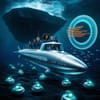Scientists are harnessing the power of Artificial Intelligence (AI) to transform the way they explore and understand Antarctica's remote ocean and its unique creatures. Researchers from British Antarctic Survey have developed an AI tool that can detect animals in photographs and videos of the seafloor in just a few seconds, a task that previously took several hours. This breakthrough technology has the potential to revolutionize the field of marine biology and conservation in Antarctica.
The AI model was trained on high-resolution images from the Weddell Sea, taken by Germany's polar research ship, RV Polarstern, and can identify common seafloor creatures like starfish, corals, sponges, and fish. This enables researchers to cover a much larger area of the seafloor, helping them decide which parts of Antarctica need special protection. The AI tool provides crucial information for policymakers to protect vulnerable ecosystems and species, and its strong potential for discovering new species and understanding biodiversity is a significant bonus.
The Antarctic seafloor is home to over 94% of all species known from the Southern Ocean, most of which are found nowhere else on Earth. As climate change and human activities threaten these specially evolved animals, this AI technology is a game-changer for conservation efforts, enabling rapid data collection without disturbing the vulnerable environment. Dr. Cameron Trotter, Machine Learning Research Scientist at British Antarctic Survey, emphasizes the significance of this technology, stating that it will "massively speed up how marine biologists analyze the data they collect."
The impact of this AI technology is substantial, allowing researchers to process over 30,000 images from the Antarctic Peninsula and Weddell Sea. This rapid analysis will accelerate our understanding of these unique and globally important ecosystems, ultimately informing effective conservation strategies. By leveraging AI, scientists can now analyze far more data than ever before, shedding light on the secrets of Antarctica's seafloor and paving the way for groundbreaking discoveries.


